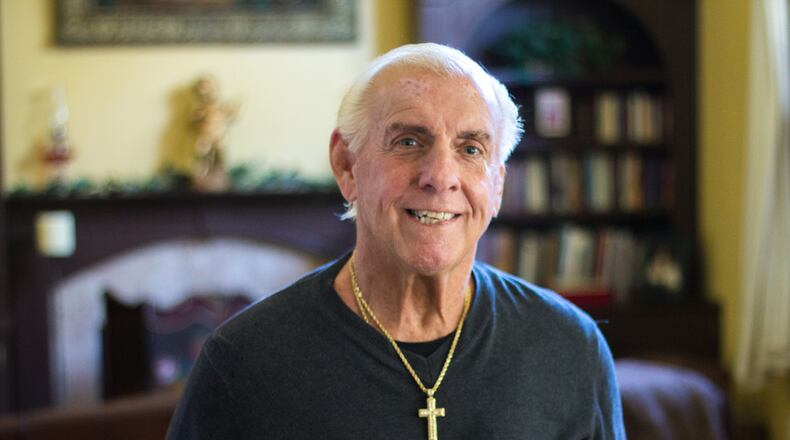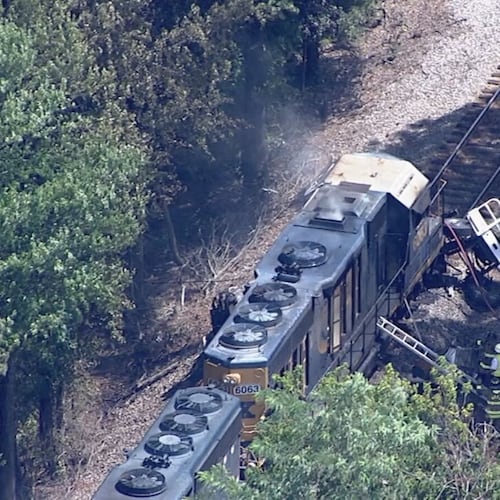Ric Flair can’t stop the “Nature Boy.” The professional wrestler, whom many fans consider the greatest of all time, has always upheld the on-camera persona of a self-proclaimed “stylin’, profilin’, limousine-riding, jet-flying, kiss-stealing, wheelin’ n’ dealin’ son of a gun.”
But when on Tuesday, Nov. 7, ESPN Films premieres its “Nature Boy” “30 for 30” documentary, the American television audience will be introduced to a question Flair himself still cannot answer: Where does Ric Flair stop, and Richard Morgan Fliehr, 68, begin?
As the documentary details, Flair is an almost pathological extrovert who has spent much of the past 30 years drinking and socializing in public places, riffing with bartenders and fans, and flirting with women. His fiancee, former WCW talent Wendy Barlow, thinks she understands why.
“He’s never discovered what he likes, or what he wants to do beyond being Ric Flair. All the going out, it’s about him getting older, and still needing to get the attention and accolades from fans,” she says. In addition to feeding Flair’s ego, the wrestler himself suggests his drinking problem was masked beneath the social nature of his habit.
Credit: AJC
“I never drank at home alone. I liked to be amongst the people. But I drank 20 vodkas a day easy,” says Flair. “I spent almost $1.2 million on drinking last year alone.”
Drinking has not been Flair’s only traditional vice. He echoed in our interview the claim from the forthcoming “30 for 30” that he has slept with more than 10,000 women, reportedly including actress Halle Berry.
“I had three major problems. I was as addicted to women as I was to wrestling and liquor. I said 10,000 women, but that’s rough math. It could’ve been 8,500. I needed company at night, man. What are you gonna do? Gotta find something to do at night in Kansas.”
Flair has been married and divorced four times. Flair tells other stories, too. About his son Reid’s heroin overdose, for which Flair blames himself.
“He died on my watch. The night my son died, I didn’t call the police. I knew he was high, but I didn’t know it was on heroin. And I went to bed thinking he needed to sleep it off, and I had been drinking, and in the morning, he was gone.”
Flair says he moved to Atlanta because of The Charlotte Observer’s coverage of his son’s heroin overdose death.
He bemoans the notion that his life makes headlines at every transgression. Yet, he profits from his public persona and leverages it to make his living. So where in all of that does Flair end, or Fliehr begin?
On Aug. 11, 2017, both nearly met their shared end, when Flair — a Lawrenceville resident — left the Arena Tavern bar with a stomachache. He’d spent the day drinking vodka and eating oysters, but the pain felt different than illness from food or alcohol.
Within hours of Flair getting home, Barlow had checked Flair into a Gwinnett hospital, where doctors said Flair was experiencing congestive heart, liver and kidney failure, and that an obstructed section of Flair's bowel required removal. Flair was ultimately placed in a medically induced coma for 10 days while doctors treated those issues, and inserted a pacemaker into Flair's heart. Doctors told family to return to Atlanta to say goodbye to Flair (and Fliehr), whom they gave a less than 1 in 5 chance to live.
Flair did live, and he was released on Sept. 21. He says his medical bills for the recent emergency ran above $1 million, and that his recovery included learning to walk again.
For Flair, the brush with death showed him the need for a calmer life surrounded by people he can trust.
As ESPN’s “Nature Boy” and Flair’s new autobiography, “Second Nature,” suggest — not knowing whom to trust, in the case of Flair, is an uncertainty Flair could perhaps extend even to himself. For now, though, Flair insists he is a changed man.
“Two months clean! I don’t know what is next, exactly. But I’m never drinking again. And I did discover binge-watching Netflix this month. And I do hope to use this experience in a positive way.”
TV PREVIEW
ESPN Films’ “Nature Boy”
10 p.m. Nov. 7, ESPN. www.espn.com/30for30/.
About the Author
The Latest
Featured




